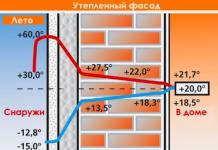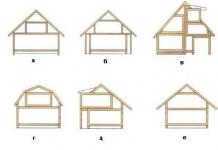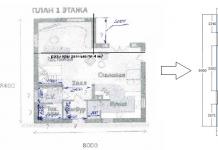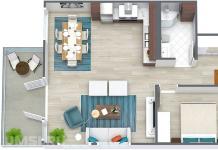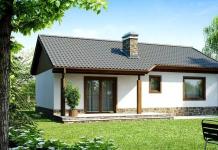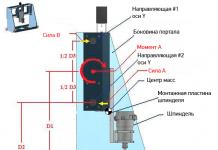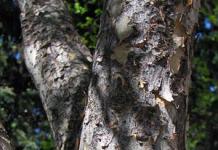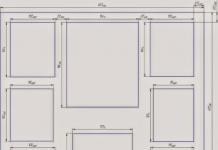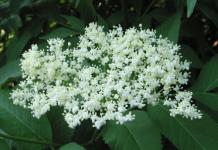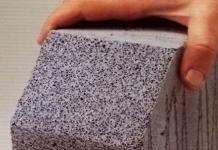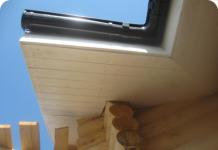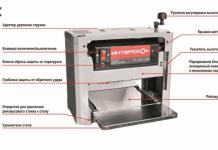Free download SNiP II-23-81 * - Steel structures
SNiP II-23-81 *
1. GENERAL PROVISIONS
1.1. These standards should be observed when designing steel building structures of buildings and structures for various purposes.
The standards do not apply to the design of steel structures of bridges, transport tunnels and pipes under embankments.
When designing steel structures that are in special operating conditions (for example, structures of blast furnaces, main and process pipelines, tanks for special purposes, structures of buildings exposed to seismic, intense temperature effects or aggressive environments, structures of offshore hydraulic structures), structures of unique buildings and structures, as well as special types of structures (for example, prestressed, spatial, hanging), additional requirements should be observed that reflect the features of the operation of these structures, provided for by the relevant regulatory documents, approved or agreed Gosstroy of the USSR.
1.2. When designing steel structures, the norms of SNiP for the protection of building structures against corrosion and fire safety standards for the design of buildings and structures should be observed. An increase in the thickness of rolled products and pipe walls in order to protect structures from corrosion and increase the fire resistance of structures is not allowed.
All structures must be accessible for observation, cleaning, painting, and must not retain moisture and hinder ventilation. Closed profiles must be sealed.
STEEL STRUCTURES
SNiP II-23-81*
__________________
Contributed by TsNIISK them. Kucherenko Gosstroy of the USSR
Instead of SNiP II-B.3-72; SNiP II-I.9-62; CH 376-67
These standards are developed in the development of GOST 27751-88 “Reliability of building structures and foundations. Basic provisions for calculation” and ST SEV 3972-83 “Reliability of building structures and foundations. Steel structures. Basic provisions for the calculation.
With the introduction of these building codes and regulations, the following shall cease to be valid:
SNiP II-B.3-72 “Steel structures. Design standards”;
changes to SNiP II-B.3-72 “Steel structures. Design standards”, approved by the resolutions of the Gosstroy of the USSR:
SNiP II-I.9-62 “Power transmission lines with voltage above 1 kV. Design standards” (section “Design of steel structures of overhead transmission line supports”);
changes to SNiP II-I.9-62 “Power transmission lines with voltage above 1 kV. Design Standards”, approved by the Decree of the Gosstroy of the USSR of April 10, 1975;
"Guidelines for the design of metal structures of antenna structures of communication facilities" (SN 376-67).
Changes were made to SNiP II-23-81 * approved by the resolutions of the USSR Gosstroy No. 120 of July 25, 1984, No. 218 of December 11, 1985, No. 69 of December 29, 1986, No. 132 of July 8, 1988, No. 121 of July 12, 1989
The main letter designations are given in appendix. 9*.
Sections, paragraphs, tables, formulas, applications and captions to figures that have been amended are marked in these building codes and rules with an asterisk.
Editors - engineers F.M. Shlemin, IN.P. Poddubny(Gosstroy of the USSR), Doctor of Engineering. Sciences prof. IN.A. Baldin, cand. tech. Sciences G.E. Velsky(TsNIISK Gosstroy of the USSR), engineer. E.M. Bukharin(“Energosetproekt” of the Ministry of Energy of the USSR), engineer. H.IN. Shevelev(SKB Mosgidrostal of the Ministry of Energy of the USSR).
When using a regulatory document, one should take into account the approved changes in building codes and rules and state standards published in the Bulletin of Construction Equipment magazine, the Collection of Changes to Building Codes and Rules of the Gosstroy of the USSR and the information index "State Standards of the USSR" of the State Standard of the USSR.
1. GENERAL PROVISIONS
1.1. These standards should be observed when designing steel building structures of buildings and structures for various purposes.
The standards do not apply to the design of steel structures of bridges, transport tunnels and pipes under embankments.
When designing steel structures that are in special operating conditions (for example, structures of blast furnaces, main and process pipelines, tanks for special purposes, structures of buildings exposed to seismic, intense temperature effects or aggressive environments, structures of offshore hydraulic structures), structures of unique buildings and structures, as well as special types of structures (for example, prestressed, spatial, hanging), additional requirements should be observed that reflect the features of the operation of these structures, provided for by the relevant regulatory documents, approved or agreed Gosstroy of the USSR.
1.2. When designing steel structures, the norms of SNiP for the protection of building structures against corrosion and fire safety standards for the design of buildings and structures should be observed. An increase in the thickness of rolled products and pipe walls in order to protect structures from corrosion and increase the fire resistance of structures is not allowed.
All structures must be accessible for observation, cleaning, painting, and must not retain moisture and hinder ventilation. Closed profiles must be sealed.
1.3*. When designing steel structures, you should:
choose the optimal schemes of structures and sections of elements in technical and economic terms;
apply economical rolled profiles and efficient steels;
apply for buildings and structures, as a rule, unified standard or standard designs;
apply progressive structures (spatial systems of standard elements; structures that combine load-bearing and enclosing functions; prestressed, cable-stayed, thin-sheet and combined structures made of different steels);
provide for the manufacturability of the manufacture and installation of structures;
apply designs that ensure the least laboriousness of their manufacture, transportation and installation;
provide, as a rule, in-line production of structures and their conveyor or large-block installation;
provide for the use of factory connections of progressive types (automatic and semi-automatic welding, flange connections, with milled ends, on bolts, including high-strength ones, etc.);
provide, as a rule, mounting connections on bolts, including high-strength ones; welded field connections are allowed with appropriate justification;
comply with the requirements of state standards for structures of the corresponding type.
1.4. When designing buildings and structures, it is necessary to adopt structural schemes that ensure the strength, stability and spatial immutability of buildings and structures as a whole, as well as their individual elements during transportation, installation and operation.
1.5*. Steels and connection materials, restrictions on the use of steels S345T and S375T, as well as additional requirements for the supplied steel, provided for by state standards and CMEA standards or technical conditions, should be indicated in the working (KM) and detailing (KMD) drawings of steel structures and in the documentation for ordering materials.
Depending on the features of the structures and their components, it is necessary to indicate the continuity class in accordance with GOST 27772-88 when ordering steel.
1.6*. Steel structures and their calculation must meet the requirements of GOST 27751-88 "Reliability of building structures and foundations. Basic provisions for calculation" and ST SEV 3972-83 "Reliability of building structures and foundations. Steel structures. Basic provisions for calculation".
1.7. Design schemes and the basic prerequisites for the calculation should reflect the actual operating conditions of steel structures.
Steel structures should, as a rule, be calculated as single spatial systems.
When dividing unified spatial systems into separate flat structures, one should take into account the interaction of elements with each other and with the base.
The choice of design schemes, as well as methods for calculating steel structures, must be made taking into account the effective use of computers.
1.8. The design of steel structures should, as a rule, be performed taking into account inelastic deformations of steel.
For statically indeterminate structures, the calculation method for which, taking into account inelastic deformations of steel, has not been developed, the design forces (bending and torsional moments, longitudinal and transverse forces) should be determined under the assumption of elastic deformations of steel according to an undeformed scheme.
With an appropriate feasibility study, the calculation is allowed to be carried out according to a deformed scheme, taking into account the effect of movements of structures under load.
1.9. Elements of steel structures must have minimum sections that meet the requirements of these standards, taking into account the assortment for rolled products and pipes. In the composite sections established by calculation, the understress should not exceed 5%.
2. MATERIALS FOR STRUCTURES AND CONNECTIONS
2.1*. Depending on the degree of responsibility of the structures of buildings and structures, as well as on the conditions of their operation, all structures are divided into four groups. Steel for steel structures of buildings and structures should be taken according to Table. 50*.
Steels for structures erected in climatic regions I 1, I 2, II 2 and II 3, but operated in heated rooms, should be taken as for the climatic region II 4 according to table. 50*, except for steel C245 and C275 for group 2 design.
For flange connections and frame units, rolled products according to TU 14-1-4431-88 should be used.
2.2*. For welding steel structures, the following should be used: electrodes for manual arc welding according to GOST 9467-75*; welding wire according to GOST 2246-70*; fluxes according to GOST 9087-81*; carbon dioxide according to GOST 8050-85.
The used welding materials and welding technology must ensure the value of the temporary resistance of the weld metal is not lower than the standard value of the temporary resistance Run the base metal, as well as the values of hardness, impact strength and relative elongation of the metal of welded joints, established by the relevant regulatory documents.
2.3*. Castings (supporting parts, etc.) for steel structures should be designed from carbon steel grades 15L, 25L, 35L and 45L, which meets the requirements for casting groups II or III according to GOST 977-75 *, as well as from gray cast iron grades SCH15, SCH20, SCH25 and SCH30, meeting the requirements of GOST 1412-85.
2.4*. For bolted connections, use steel bolts and nuts that meet the requirements of GOST 1759.0-87*, GOST 1759.4-87* and GOST 1759.5-87*, and washers that meet the requirements of GOST 18123-82*.
Bolts should be assigned according to the table. 57* and GOST 15589-70*, GOST 15591-70*, GOST 7796-70*, GOST 7798-70*, and when limiting joint deformations - according to GOST 7805-70*.
Nuts should be used in accordance with GOST 5915-70 *: for bolts of strength classes 4.6, 4.8, 5.6 and 5.8 - nuts of strength class 4; for bolts of strength classes 6.6 and 8.8 - nuts of strength classes 5 and 6, respectively, for bolts of strength class 10.9 - nuts of strength class 8.
Washers should be used: round according to GOST 11371-78*, oblique according to GOST 10906-78* and spring normal according to GOST 6402-70*.
2.5*. The choice of steel grades for foundation bolts should be made in accordance with GOST 24379.0-80, and their design and dimensions should be taken in accordance with GOST 24379.1-80 *.
Bolts (U-shaped) for fastening guy wires of antenna communication structures, as well as U-shaped and foundation bolts of overhead power transmission lines and switchgears should be used from steel grades: 09G2S-8 and 10G2S1-8 in accordance with GOST 19281-73 * with an additional requirement for impact strength at a temperature of minus 60 ° C at least 30 J / cm 2 (3 kgf × m / cm 2) in climatic region I 1; 09G2S-6 and 10G2S1-6 according to GOST 19281-73* in climatic regions I 2 , II 2 and II 3 ; VSt3sp2 according to GOST 380-71* (since 1990 St3sp2-1 according to GOST 535-88) in all other climatic regions.
2.6*. Nuts for foundation and U-bolts should be used:
for bolts made of steel grades Vst3sp2 and 20 - strength class 4 according to GOST 1759.5-87 *;
for bolts made of steel grades 09G2S and 10G2S1 - strength class not lower than 5 according to GOST 1759.5-87 *. It is allowed to use nuts from steel grades accepted for bolts.
Nuts for foundation and U-shaped bolts with a diameter of less than 48 mm should be used in accordance with GOST 5915-70*, for bolts with a diameter of more than 48 mm - in accordance with GOST 10605-72*.
2.7*. High-strength bolts should be used in accordance with GOST 22353-77*, GOST 22356-77* and TU 14-4-1345-85; nuts and washers for them - according to GOST 22354-77* and GOST 22355-77*.
2.8*. For load-bearing elements of hanging coatings, guy wires of overhead lines and switchgear supports, masts and towers, as well as prestressing elements in prestressed structures, the following should be used:
spiral ropes according to GOST 3062-80*; GOST 3063-80*, GOST 3064-80*;
double lay ropes according to GOST 3066-80*; GOST 3067-74*; GOST 3068-74*; GOST 3081-80*; GOST 7669-80*; GOST 14954-80*;
ropes closed bearing according to GOST 3090-73*; GOST 18900-73* GOST 18901-73*; GOST 18902-73*; GOST 7675-73*; GOST 7676-73*;
bundles and strands of parallel wires formed from rope wire meeting the requirements of GOST 7372-79*.
2.9. The physical characteristics of the materials used for steel structures should be taken in accordance with Annex. 3.
3. CALCULATED CHARACTERISTICS OF MATERIALS AND COMPOUNDS
3.1*. The design resistance of rolled products, bent profiles and pipes for various types of stress states should be determined by the formulas given in Table. 1*.
Table 1*
|
stressed state |
Symbol |
Calculated resistance of rolled products and pipes |
|
|
stretching, |
Yield strength |
Ry = Ryn /gm |
|
|
compression and bending |
According to temporary resistance |
R u = Run /gm |
|
|
Rs = 0,58Ryn /gm |
|||
|
End face wrinkle (if fitted) |
Rp = Run /gm |
||
|
Local collapse in cylindrical hinges (pins) with tight contact |
Rlp = 0,5Run /gm |
||
|
Diametric compression of rollers (with free touch in structures with limited mobility) |
Rcd = 0,025Run /gm |
||
|
Stretching in the direction of the rolled thickness (up to 60 mm) |
Rth = 0,5Run /gm |
||
|
The designation adopted in Table. 1*: |
|||
|
gm- reliability coefficient for the material, determined in accordance with clause 3.2*. |
|||
3.2*. The values of the reliability factors for the material of rolled products, bent profiles and pipes should be taken from Table. 2*.
Table 2*
|
State standard or technical conditions for rental |
Safety factor by material g m |
|
GOST 27772-88 (except for steels S590, S590K); TU 14-1-3023-80 (for circle, square, strip) |
|
|
GOST 27772-88 (steels S590, S590K); GOST 380-71** (for circles and squares with dimensions not included in TU 14-1-3023-80); GOST 19281-73 * [for a circle and a square with a yield strength of up to 380 MPa (39 kgf / mm 2) and dimensions that are not in TU 14-1-3023-80]; GOST 10705-80*; GOST 10706-76* |
|
|
GOST 19281-73 * [for a circle and a square with a yield strength of more than 380 MPa (39 kgf / mm 2) and dimensions that are not in TU 14-1-3023-80]; GOST 8731-87; TU 14-3-567-76 |
The calculated resistances in tension, compression and bending of sheet, broadband universal and shaped steel are given in table. 51 *, pipes - in the table. 51, a. The design resistance of bent profiles should be taken equal to the design resistance of the rolled sheet from which they are made, while it is allowed to take into account the hardening of steel sheet rolled in the bending zone.
The design resistance of round, square and strip products should be determined from Table. 1*, taking values Ryn And Run equal respectively to the yield strength and tensile strength according to TU 14-1-3023-80, GOST 380-71** (since 1990 GOST 535-88) and GOST 19281-73*.
The design resistance of rolled products to the collapse of the end surface, local collapse in cylindrical hinges and diametrical compression of the rollers are given in Table. 52*.
3.3. The design resistance of castings made of carbon steel and gray cast iron should be taken from Table. 53 and 54.
3.4. The design resistance of welded joints for various types of joints and stress states should be determined by the formulas given in Table. 3.
Table 3
|
Welded joints |
Voltage state |
Symbol |
Design resistance of welded joints |
|
|
Butt |
Compression. Tensile and bending during automatic, semi-automatic or manual welding with physical quality control of seams |
Yield strength |
Rwy = Ry |
|
|
According to temporary resistance |
Rwu = R u |
|||
|
Tensile and bending during automatic, semi-automatic or manual welding |
Yield strength |
Rwy = 0,85Ry |
||
|
Rws = Rs |
||||
|
with corner seams |
Slice (conditional) Rwz = 0,45Run |
|||
|
Notes: 1. For manual welds, the values R wun should be taken equal to the values of the tensile strength of the weld metal specified in GOST 9467-75 *. 2. For seams performed by automatic or semi-automatic welding, the value R wun should be taken according to the table. 4* of these standards. 3. Values of the safety factor for the weld material gwm should be taken equal: 1.25 - at values R wun no more than 490 MPa (5,000 kgf / cm 2); 1.35 - at values R wun 590 MPa (6,000 kgf / cm 2) and more. |
||||
The calculated resistances of butt joints of elements made of steels with different standard resistances should be taken as for butt joints made of steel with a lower value of standard resistance.
The calculated resistances of the weld metal of welded joints with fillet welds are given in Table. 56.
3.5. The design resistance of single-bolt connections should be determined by the formulas given in Table. 5*.
The design resistance to shear and tension of the bolts are given in Table. 58 *, the collapse of the elements connected by bolts - in table. 59*.
3.6*. Design tensile strength of foundation bolts Rba
Rba = 0,5R. (1)
Design tensile strength of U-bolts Rbv specified in clause 2.5* should be determined by the formula
Rbv = 0,45Run. (2)
The calculated tensile strength of the foundation bolts are given in Table. 60*.
3.7. Design tensile strength of high strength bolts Rbh should be determined by the formula
Rbh = 0,7Rbun, (3)
Where Rbun- the smallest tensile strength of the bolt, taken according to Table. 61*.
3.8. Design tensile strength of high strength steel wire R dh applied in the form of bundles or strands should be determined by the formula
R dh = 0,63Run. (4)
3.9. The value of the design resistance (force) to stretching of the steel rope should be taken equal to the value of the breaking force of the rope as a whole, established by state standards or specifications for steel ropes, divided by the reliability factor g m = 1,6.
SNiP II-23-81*
Instead
SNiP II-B.3-72;
SNiP II-I.9-62; CH 376-67
STEEL STRUCTURES
1. GENERAL PROVISIONS
1.1. These standards should be observed when designing steel building structures of buildings and structures for various purposes.
The standards do not apply to the design of steel structures of bridges, transport tunnels and pipes under embankments.
When designing steel structures that are in special operating conditions (for example, structures of blast furnaces, main and process pipelines, tanks for special purposes, structures of buildings exposed to seismic, intense temperature effects or aggressive environments, structures of offshore hydraulic structures), structures of unique buildings and structures, as well as special types of structures (for example, prestressed, spatial, hanging), additional requirements should be observed that reflect the features of the operation of these structures, provided for by the relevant regulatory documents, approved or agreed Gosstroy of the USSR.
1.2. When designing steel structures, the norms of SNiP for the protection of building structures against corrosion and fire safety standards for the design of buildings and structures should be observed. An increase in the thickness of rolled products and pipe walls in order to protect structures from corrosion and increase the fire resistance of structures is not allowed.
All structures must be accessible for observation, cleaning, painting, and must not retain moisture and hinder ventilation. Closed profiles must be sealed.
1.3*. When designing steel structures, you should:
choose the optimal schemes of structures and sections of elements in technical and economic terms;
apply economical rolled profiles and efficient steels;
apply for buildings and structures, as a rule, unified standard or standard designs;
apply progressive structures (spatial systems of standard elements; structures that combine load-bearing and enclosing functions; prestressed, cable-stayed, thin-sheet and combined structures made of different steels);
provide for the manufacturability of the manufacture and installation of structures;
apply designs that ensure the least laboriousness of their manufacture, transportation and installation;
provide, as a rule, in-line production of structures and their conveyor or large-block installation;
provide for the use of factory connections of progressive types (automatic and semi-automatic welding, flange connections, with milled ends, on bolts, including high-strength ones, etc.);
provide, as a rule, mounting connections on bolts, including high-strength ones; welded field connections are allowed with appropriate justification;
comply with the requirements of state standards for structures of the corresponding type.
1.4. When designing buildings and structures, it is necessary to adopt structural schemes that ensure the strength, stability and spatial immutability of buildings and structures as a whole, as well as their individual elements during transportation, installation and operation.
1.5*. Steels and connection materials, restrictions on the use of steels S345T and S375T, as well as additional requirements for the supplied steel, provided for by state standards and CMEA standards or technical conditions, should be indicated in the working (KM) and detailing (KMD) drawings of steel structures and in the documentation for ordering materials.
Depending on the features of the structures and their units, it is necessary to indicate the continuity class according to when ordering steel.
1.6*. Steel structures and their calculation must meet the requirements of "Reliability of building structures and foundations. Basic provisions for calculation" and ST SEV 3972 - 83 "Reliability of building structures and foundations. Steel structures. Basic provisions for the calculation."
1.7. Design schemes and the basic prerequisites for the calculation should reflect the actual operating conditions of steel structures.
Steel structures should, as a rule, be calculated as single spatial systems.
When dividing unified spatial systems into separate flat structures, one should take into account the interaction of elements with each other and with the base.
The choice of design schemes, as well as methods for calculating steel structures, must be made taking into account the effective use of computers.
1.8. The design of steel structures should, as a rule, be performed taking into account inelastic deformations of steel.
For statically indeterminate structures, the calculation method for which, taking into account inelastic deformations of steel, has not been developed, the design forces (bending and torsional moments, longitudinal and transverse forces) should be determined under the assumption of elastic deformations of steel according to an undeformed scheme.
With an appropriate feasibility study, the calculation is allowed to be carried out according to a deformed scheme, taking into account the effect of movements of structures under load.
1.9. Elements of steel structures must have minimum sections that meet the requirements of these standards, taking into account the assortment for rolled products and pipes. In the composite sections established by calculation, the understress should not exceed 5%.
2. MATERIALS FOR STRUCTURES AND CONNECTIONS
2.1*. Depending on the degree of responsibility of the structures of buildings and structures, as well as on the conditions of their operation, all structures are divided into four groups. Steel for steel structures of buildings and structures should be taken according to Table. 50*.
Steels for structures erected in climatic regions I 1, I 2, II 2 and II 3, but operated in heated rooms, should be taken as for the climatic region II 4 according to table. 50*, except for steel C245 and C275 for group 2 design.
For flange connections and frame units, rolled products according to TU 14-1-4431 should be used – 88.
2.2*. For welding steel structures, the following should be used: electrodes for manual arc welding according to GOST 9467-75*; welding wire according to GOST 2246 – 70*; fluxes according to GOST 9087 – 81*; carbon dioxide according to GOST 8050 – 85.
The used welding materials and welding technology must ensure the value of the temporary resistance of the weld metal is not lower than the standard value of the temporary resistance Run the base metal, as well as the values of hardness, impact strength and relative elongation of the metal of welded joints, established by the relevant regulatory documents.
2.3*. Castings (supporting parts, etc.) for steel structures should be designed from carbon steel grades 15L, 25L, 35L and 45L, meeting the requirements for casting groups II or III in accordance with GOST 977 - 75 *, as well as from gray cast iron grades SCH15, SCH20, SCH25 and SCH30, which meets the requirements of GOST 1412 – 85.
2.4*. For bolted connections, steel bolts and nuts should be used that meet the requirements *, GOST 1759.4 – 87* and GOST 1759.5 - 87 *, and washers that meet the requirements *.
Bolts should be assigned according to Table 57* and *, *, GOST 7796-70*, GOST 7798-70*, and when limiting joint deformations - according to GOST 7805-70*.
Nuts should be used in accordance with GOST 5915 – 70*: for bolts of property classes 4.6, 4.8, 5.6 and 5.8 – nuts of strength class 4; for bolts of property classes 6.6 and 8.8 - nuts of strength classes 5 and 6, respectively, for bolts of strength class 10.9 – nuts of strength class 8.
Washers should be used: round according to GOST 11371 – 78*, oblique according to GOST 10906 - 78 * and spring normal according to GOST 6402 – 70*.
2.5*. The choice of steel grades for foundation bolts should be made according to, and their design and dimensions should be taken according to *.
Bolts (U-shaped) for fastening guy wires of antenna communication structures, as well as U-shaped and foundation bolts of supports for overhead power lines and switchgears should be used from steel grades: 09G2S-8 and 10G2S1-8 according to GOST 19281 – 73* with an additional requirement for impact strength at a temperature of minus 60 ° C at least 30 J / cm 2 (3 kgf × m / cm 2) in the climatic region I 1; 09G2S-6 and 10G2S1-6 according to GOST 19281 – 73* in climatic regions I 2 , II 2 and II 3 ; Vst3sp2 according to GOST 380 - 71 * (since 1990 St3sp2-1 according to GOST 535 – 88) in all other climatic regions.
2.6*. Nuts for foundation and U-bolts should be used:
for bolts made of steel grades Vst3sp2 and 20 – strength class 4 according to GOST 1759.5 – 87*;
for bolts made of steel grades 09G2S and 10G2S1 – strength class not less than 5 according to GOST 1759.5 – 87*. It is allowed to use nuts from steel grades accepted for bolts.
Nuts for foundation and U-bolts with a diameter of less than 48 mm should be used in accordance with GOST 5915 – 70*, for bolts with a diameter of more than 48 mm – according to GOST 10605 – 72*.
2.7*. High-strength bolts should be used according to *, * and TU 14-4-1345 - 85; nuts and washers for them – according to GOST 22354 - 77* and *.
2.8*. For load-bearing elements of hanging coatings, guy wires of overhead lines and switchgear supports, masts and towers, as well as prestressing elements in prestressed structures, the following should be used:
spiral ropes according to GOST 3062 – 80*; GOST 3063 – 80*, GOST 3064 – 80*;
double lay ropes according to GOST 3066 – 80*; GOST 3067 – 74*; GOST 3068 – 74*; GOST 3081 – 80*; GOST 7669 – 80*; GOST 14954 – 80*;
ropes closed bearing according to GOST 3090 – 73*; GOST 18900 – 73* GOST 18901 – 73*; GOST 18902 – 73*; GOST 7675 – 73*; GOST 7676 – 73*;
bundles and strands of parallel wires formed from rope wire meeting the requirements of GOST 7372 – 79*.
2.9. The physical characteristics of the materials used for steel structures should be taken in accordance with Annex. 3.
3. CALCULATED CHARACTERISTICS OF MATERIALS AND COMPOUNDS
3.1*. The design resistance of rolled products, bent profiles and pipes for various types of stress states should be determined by the formulas given in Table. 1*.
Table 1*
| stressed state | Symbol | Calculated resistance of rolled products and pipes | |
| stretching, | Yield strength | Ry | R y = R yn /g m |
| compression and bending | According to temporary resistance | R u | R u = R un /g m |
| Rs | Rs = 0.58R yn / g m | ||
|
End face wrinkle (if fitted) |
Rp | R p = R un /g m | |
|
Local collapse in cylindrical hinges (pins) with tight contact |
Rlp | Rlp= 0.5 R un / g m | |
|
Diametric compression of rollers (with free touch in structures with limited mobility) |
Rcd | Rcd= 0.025R un / g m | |
|
Stretching in the direction of the rolled thickness (up to 60 mm) |
Rth | Rth= 0.5 R un / g m | |
|
The designation adopted in Table. 1*: |
|||
|
g m - reliability coefficient for the material, determined in accordance with clause 3.2 *. |
|||
3.2*. The values of the reliability factors for the material of rolled products, bent profiles and pipes should be taken from Table. 2*.
Table 2*
| State standard or technical conditions for rental | Safety factor by material g m |
|
(except for steels S590, S590K); TU 14-1-3023 – 80 (for circle, square, stripe) |
1,025 |
|
(steels S590, S590K); GOST 380 – 71** (for a circle and a square with dimensions not included in TU 14-1-3023 – 80); GOST 19281 - 73 * [for a circle and a square with a yield strength of up to 380 MPa (39 kgf / mm 2) and dimensions that are not in TU 14-1-3023 – 80]; *; * |
1,050 |
|
GOST 19281 - 73 * [for a circle and a square with a yield strength of over 380 MPa (39 kgf / mm 2) and dimensions that are not in TU 14-1-3023 – 80]; GOST 8731 - 87; TU 14-3-567 – 76 |
1,100 |
The calculated resistances in tension, compression and bending of sheet, broadband universal and shaped steel are given in table. 51*, pipes - in table. 51, a. The design resistance of bent profiles should be taken equal to the design resistance of the rolled sheet from which they are made, while it is allowed to take into account the hardening of steel sheet rolled in the bending zone.
The design resistance of round, square and strip products should be determined from Table. 1*, taking values Ryn And Run equal, respectively, to the yield strength and tensile strength according to TU 14-1-3023 - 80, GOST 380 – 71** (since 1990 GOST 535 - 88) and GOST 19281 – 73*.
The design resistance of rolled products to the collapse of the end surface, local collapse in cylindrical hinges and diametrical compression of the rollers are given in Table. 52*.
3.3. The design resistance of castings made of carbon steel and gray cast iron should be taken from Table. 53 and 54.
3.4. The design resistance of welded joints for various types of joints and stress states should be determined by the formulas given in Table. 3.
Table 3
| Welded joints | Voltage state | Symbol | Design resistance of welded joints | |
| Butt |
Compression. Tensile and bending during automatic, semi-automatic or manual welding with physical |
Yield strength | Rwy | Rwy=Ry |
|
seam quality control |
According to temporary resistance | Rwu | Rwu= R u | |
|
Tensile and bending during automatic, semi-automatic or manual welding |
Yield strength | Rwy | Rwy= 0.85Ry | |
| Shift | Rws | Rws= Rs | ||
| with corner seams | Slice (conditional) | For weld metal | Rwf | |
| For metal fusion boundaries | Rwz | Rwz= 0.45Run | ||
|
Notes: 1. For manual welds, the values R wun should be taken equal to the values of the tensile strength of the weld metal specified in GOST 9467-75 *. 2. For seams performed by automatic or semi-automatic welding, the value of R wun should be taken from Table. 4* of these standards. 3. Values of the safety factor for the weld material gwm should be taken equal: 1.25 - for values R wun no more than 490 MPa (5,000 kgf / cm 2); 1.35 - for values R wun 590 MPa (6,000 kgf / cm 2) and more. |
||||
The calculated resistances of butt joints of elements made of steels with different standard resistances should be taken as for butt joints made of steel with a lower value of standard resistance.
The calculated resistances of the weld metal of welded joints with fillet welds are given in Table. 56.
3.5. The design resistance of single-bolt connections should be determined by the formulas given in Table. 5*.
The design resistance to shear and tension of the bolts are given in Table. 58*, crushing of elements connected by bolts, - in table. 59*.
3.6*. Design tensile strength of foundation bolts Rba
Rba = 0,5R. (1)
Design tensile strength of U-bolts Rbv specified in clause 2.5* should be determined by the formula
R bv = 0,45Run. (2)
The calculated tensile strength of the foundation bolts are given in Table. 60*.
3.7. Design tensile strength of high strength bolts Rbh should be determined by the formula
Rbh = 0,7Rbun, (3)
Where Rbun - the smallest tensile strength of the bolt, taken according to Table. 61*.
3.8. Design tensile strength of high strength steel wire R dh applied in the form of bundles or strands should be determined by the formula
R dh = 0,63Run. (4)
3.9. The value of the design resistance (force) to stretching of the steel rope should be taken equal to the value of the breaking force of the rope as a whole, established by state standards or specifications for steel ropes, divided by the reliability factor g m = 1,6.
Table 4*
| Wire grades (according to GOST 2246 – 70*) for automatic or semi-automatic welding | Powder grades | Values of the normative | |
| submerged arc (GOST 9087 – 81*) | in carbon dioxide (according to GOST 8050 - 85) or in its mixture with argon (according to GOST 10157 – 79*) | wire (according to GOST 26271 – 84) | weld metal resistance R wun, MPa (kgf / cm 2) |
|
Sv-08, Sv-08A |
– | – | 410 (4200) |
| – | – | 450 (4600) | |
| Sv-08G2S | PP-AN8, PP-AN3 | 490 (5000) | |
|
Sv-10NMA, Sv-10G2 |
Sv-08G2S* | – | 590 (6000) |
|
Sv-09HN2GMYu |
Sv-10KhG2SMA Sv-08KhG2DYU | – | 685 (7000) |
|
* When welding with Sv-08G2S wire, the values R wun should be taken equal to 590 MPa (6000 kgf / cm 2) only for fillet welds with a leg kf £ 8 mm in steel structures with a yield strength of 440 MPa (4500 kgf / cm 2) and more. |
|||
Table 5*
| Calculated resistances of single-bolt connections | |||||
| stressed state | Symbol | shear and tensile bolt grade | collapse of connected elements made of steel with a yield strength of up to 440 MPa | ||
| 4.6; 5.6; 6.6 | 4.8; 5.8 | 8.8; 10.9 | (4500 kgf / cm 2) | ||
| Rbs | Rbs = 0.38Rbun | Rbs= 0.4Rbun | Rbs= 0.4Rbun | – | |
|
stretching |
Rbt | R bt s = 0.38Rbun | R bt = 0.38Rbun | R bt = 0.38Rbun | – |
| Rbp | |||||
|
a) bolts of accuracy class A |
– | – | – | ||
|
b) class B and C bolts |
– | – | – | ||
|
Note. It is allowed to use high-strength bolts without adjustable tension from steel grade 40X “select”, while the calculated resistances Rbs And Rbt should be determined as for bolts of class 10.9, and the design resistance as for bolts of accuracy class B and C. High-strength bolts according to TU 14-4-1345 - 85 is allowed to be used only when they work in tension. |
|||||
4*. CONSIDERATION OF WORKING CONDITIONS AND PURPOSE OF STRUCTURES
When calculating structures and connections, one should take into account: reliability factors for the intended purpose gn taken in accordance with the Rules for Accounting for the Degree of Responsibility of Buildings and Structures in the Design of Structures;
safety factor g u= 1.3 for structural elements calculated for strength using design resistances R u;
working conditions coefficients gc and coefficients of connection working conditions gb taken according to the table. 6 * and 35 *, sections of these standards for the design of buildings, structures and structures, as well as adj. 4*.
Table 6*
| Structural elements | Working conditions coefficients g with |
|
1. Solid beams and compressed elements of floor trusses under the halls of theaters, clubs, cinemas, under the stands, under the premises of shops, book depositories and archives, etc. with the weight of the floors equal to or greater than the live load |
0,9 |
|
2. Columns of public buildings and supports of water towers |
0,95 |
|
3. Compressed main elements (except for supporting ones) of a lattice of composite tee section from the corners of welded trusses of coatings and ceilings (for example, roof trusses and similar trusses) with flexibility l ³ 60 |
0,8 |
|
4. Solid beams in calculations for overall stability at jb 1,0 |
0,95 |
|
5. Puffs, rods, braces, hangers made of rolled steel |
0,9 |
|
6. Elements of bar structures of coatings and ceilings: |
|
|
a) compressed (with the exception of closed tubular sections) in stability calculations |
0,95 |
|
b) stretched in welded structures |
0,95 |
|
c) tensioned, compressed, as well as butt plates in bolted structures (except for structures with high-strength bolts) made of steel with a yield strength of up to 440 MPa (4500 kgf / cm 2), bearing a static load, when calculating strength |
1,05 |
|
7. Solid composite beams, columns, as well as butt plates made of steel with a yield strength of up to 440 MPa (4500 kgf / cm 2), bearing a static load and made using bolted joints (except for joints on high-strength bolts), when calculating strength |
1,1 |
|
8. Cross-sections of rolled and welded elements, as well as linings made of steel with a yield strength of up to 440 MPa (4500 kgf / cm 2) at joints made on bolts (except for joints on high-strength bolts) bearing a static load, when calculating strength: |
|
|
a) solid beams and columns |
1,1 |
|
b) bar structures and floors |
1,05 |
|
9. Compressed lattice elements of spatial lattice structures from single equal-shelf (attached with a larger shelf) corners: |
|
|
a) attached directly to the belts with one shelf with welds or two or more bolts placed along the corner: |
|
|
braces according to fig. 9*, a |
0,9 |
|
spacers according to fig. 9*, b, V |
0,9 |
|
braces according to fig. 9*, in, G, d |
0,8 |
|
b) attached directly to the belts with one shelf, with one bolt (except for those indicated in item 9, in this table), as well as attached through a gusset, regardless of the type of connection |
0,75 |
|
c) with a complex cross lattice with single-bolt connections according to fig. 9*, e |
0,7 |
|
10. Compressed elements from single corners, attached with one shelf (for unequal corners only with a smaller shelf), with the exception of the structural elements indicated in pos. 9 of this table, braces according to fig. 9*, b, attached directly to the belts with welds or two or more bolts placed along the corner, and flat trusses from single corners |
0,75 |
|
11. Base plates made of steel with a yield strength of up to 285 MPa (2900 kgf / cm 2), bearing a static load, thickness, mm: |
|
| 1,2 | |
|
b) over 40 to 60 |
1,15 |
|
c) over 60 to 80 |
1,1 |
|
Notes: 1. Working conditions coefficients g with 1 should not be taken into account at the same time in the calculation. 2. Coefficients of working conditions, given respectively in pos. 1 and 6, c; 1 and 7; 1 and 8; 2 and 7; 2 and 8a; 3 and 6, c, in the calculation should be taken into account simultaneously. 3. Coefficients of working conditions given in pos. 3; 4; 6, a, c; 7; 8; 9 and 10, as well as in pos. 5 and 6, b (except for butt welded joints), the considered elements should not be taken into account when calculating the joints. 4. In cases not specified in these rules, the formulas should take g c \u003d 1. |
|
5. CALCULATION OF STEEL STRUCTURE ELEMENTS FOR AXIAL FORCES AND BENDING
CENTRALLY STRETCHED AND CENTRALLY COMPRESSED ELEMENTS
5.1. Strength calculation of elements subject to central tension or compression by force N, except for those specified in clause 5.2, should be performed according to the formula
The calculation of the strength of the sections in the places of attachment of tensioned elements from single angles, attached by one flange with bolts, should be performed according to formulas (5) and (6). At the same time, the value g with in formula (6) should be taken according to adj. 4* of these standards.
5.2. Calculation of the strength of tensile structural members made of steel with the ratio R u/g u > Ry, the operation of which is possible even after the metal reaches the yield point, should be carried out according to the formula
5.3. Calculation for the stability of solid-walled elements subject to central compression by force N, should be performed according to the formula
Values j
at 0 £2.5
![]() ; (8)
; (8)
at 2.5 £4.5
at > 4,5
![]() . (10)
. (10)
Numerical values j are given in table. 72.
5.4*. Rods from single angles must be calculated for central compression in accordance with the requirements set out in clause 5.3. When determining the flexibility of these rods, the radius of gyration of the angle section i and estimated length lef should be taken in accordance with 6.1 – 6.7.
When calculating belts and lattice elements of spatial structures from single corners, the requirements of clause 15.10 * of these standards should be met.
5.5. Compressed elements with solid walls of an open U-shaped section at l x 3l y , Where l x And l y are the design slendernesses of the element in planes perpendicular to the axes, respectively x– x And y – y (Fig. 1), it is recommended to reinforce with planks or grating, while the requirements of paragraphs. 5.6 and 5.8*.

In the absence of strips or lattice, such elements, in addition to the calculation according to formula (7), should be checked for stability in the bending-torsional form of buckling according to the formula
Where jy - buckling coefficient calculated in accordance with the requirements of clause 5.3;
With
 (12)
(12)
Where ![]() ;
;
a = a x/ h is the relative distance between the center of gravity and the center of the bend.
Here ![]() ;
;
J w is the sectorial moment of inertia of the section;
b i And t i are the width and thickness of the rectangular elements that make up the section, respectively.
For the section shown in fig. 1, a, values ![]() And a
should be determined by the formulas:
And a
should be determined by the formulas:
Where b = b/h.
5.6. For composite compressed rods, the branches of which are connected by strips or gratings, the coefficient j relative to the free axis (perpendicular to the plane of the bars or gratings) should be determined by the formulas (8) – (10) with replacement in them by ef. Meaning ef should be determined depending on the values lef given in table. 7.
Table 7
| Type | Scheme | Reduced Flexibility lef composite rods of a through section | ||||||
| sections | sections | with slats | with bars | |||||
| Js l /( J b b) 5 | Js l /( J b b) ³ 5 | |||||||
| 1 | (14) | (17) |
|
|||||
| 2 | (15) | (18) |
|
|||||
| 3 | (16) |
|
|
|||||
| The designations adopted in Table. 7: | ||||||||
| b |
is the distance between the axes of the branches; |
|||||||
| l |
- the distance between the centers of the bars; |
|||||||
| l |
- the greatest flexibility of the entire rod; |
|||||||
| l 1 , l 2 , l 3 |
- flexibility of individual branches when they are bent in planes perpendicular to the axes, respectively 1 – 1 , 2 – 2 and 3 - 3, in the areas between the welded strips (in the light) or between the centers of the extreme bolts; |
|||||||
| A |
is the cross-sectional area of the entire rod; |
|||||||
| A d1 and A d2 |
- cross-sectional areas of the braces of the lattices (with a cross lattice - two braces) lying in planes perpendicular to the axes, respectively 1 – 1 And 2 – 2; |
|||||||
| A d |
- cross-sectional area of the lattice brace (with a cross lattice - two braces) lying in the plane of one face (for a trihedral equilateral rod); |
|||||||
| a 1 And a 2 |
- coefficients determined by the formula |
|||||||
| Where |
– dimensions determined from fig. 2; |
|||||||
|
n, n 1 , n 2 , n 3 |
are the coefficients determined by the formulas, respectively; |
|||||||
| Here |
Jb1 And Jb3 |
are the moments of inertia of the section of the branches relative to the axes, respectively 1 – 1 and 3 – 3 (for sections of types 1 and 3); |
||||||
|
Jb1 And Jb2 |
- the same, two corners relative to the axes, respectively 1 – 1 and 2 – 2 (for section type 2); |
|||||||
|
- the moment of inertia of the section of one bar relative to its own axis x– x (Fig. 3); |
||||||||
|
J s1 And J s2 |
are the moments of inertia of the section of one of the bars lying in planes perpendicular to the axes, respectively 1 – 1 and 2 – 2 (for section type 2). |
|||||||
In composite rods with lattices, in addition to the calculation for the stability of the rod as a whole, it is necessary to check the stability of individual branches in the areas between the nodes.
Flexibility of individual branches l 1 , l 2 And l 3 in the area between the slats should be no more than 40.
If there is a solid sheet in one of the planes instead of planks (Fig. 1, b, V) the flexibility of the branch must be calculated from the radius of gyration of the half-section about its axis, perpendicular to the plane of the slats.
In composite bars with gratings, the flexibility of individual branches between nodes should be no more than 80 and should not exceed the reduced flexibility lef rod as a whole. It is allowed to take higher values of the flexibility of the branches, but not more than 120, provided that the calculation of such rods is performed according to the deformed scheme.
5.7. The calculation of composite elements from angles, channels, etc., connected closely or through gaskets, should be performed as solid-walled, provided that the largest distances in the areas between the welded strips (in the light) or between the centers of the extreme bolts do not exceed:
for compressed elements 40 i
for tension members 80 i
Here the radius of gyration i corner or channel should be taken for tee or I-sections relative to an axis parallel to the plane of the gaskets, and for cross sections - minimal.
At the same time, at least two spacers should be installed within the length of the compressed element.
5.8*. The calculation of connecting elements (slats, gratings) of compressed composite rods must be performed for a conditional transverse force Qfic, taken constant over the entire length of the rod and determined by the formula
Qfic = 7,15 × 10 -6 (2330 – E/Ry)N/j , (23)*
Where N - longitudinal force in the composite rod;
j – coefficient of buckling, taken for a composite rod in the plane of the connecting elements.
Conditional transverse force Qfic should be distributed:
in the presence of only connecting strips (lattices) equally between the strips (lattices) lying in planes perpendicular to the axis relative to which the stability check is performed;
in the presence of a continuous sheet and connecting strips (grids) - in half between the sheet and the strips (lattices) lying in planes parallel to the sheet;
when calculating equilateral trihedral composite rods, the conditional transverse force attributable to the system of connecting elements located in the same plane should be taken equal to 0.8 Qfic.

5.9. The calculation of connecting strips and their attachment (Fig. 3) should be carried out as a calculation of the elements of braced trusses for:
force F, cutting bar, according to the formula
F = Q s l/b; (24)
moment M1, bending the bar in its plane, according to the formula
M1 = Q s l/2 (25)
Where Qs - conditional transverse force attributable to the bar of one face.

5.10. The calculation of the connecting grids must be carried out as the calculation of the truss grids. When calculating the cross braces of a cross lattice with spacers (Fig. 4), additional force should be taken into account N ad, arising in each brace from the compression of the chords and determined by the formula
![]() (26)
(26)
Where N - force in one branch of the rod;
A is the cross-sectional area of one branch;
A d - cross-sectional area of one brace;
a - coefficient determined by the formula
a = a l 2 /(a 3 =2b 3) (27)
Where a, l And b – dimensions shown in fig. 4.

5.11. The calculation of rods intended to reduce the calculated length of the compressed elements must be performed for a force equal to the conditional transverse force in the main compressed element, determined by formula (23)*.
BENDING ELEMENTS
5.12. The strength analysis of elements (except for beams with a flexible web, with a perforated web and crane beams), bent in one of the main planes, should be performed according to the formula
![]() (28)
(28)
The value of shear stresses t in sections of bending elements must satisfy the condition
![]() (29)
(29)
If there is a weakening of the wall by bolt holes, the values t in formula (29) should be multiplied by the coefficient a , determined by the formula
a = a/(a – d), (30)
Where a - hole pitch;
b - hole diameter.
5.13. To calculate the strength of the beam web in places where the load is applied to the upper chord, as well as in the supporting sections of the beam that are not reinforced with stiffeners, local stress should be determined s loc according to the formula
![]() (31)
(31)
Where F - the calculated value of the load (force);
lef - conditional length of load distribution, determined depending on the conditions of support; for the case of support according to Fig. 5.
lef = b + 2tf, (32)
Where tf - the thickness of the upper chord of the beam, if the lower beam is welded (Fig. 5, A), or the distance from the outer edge of the flange to the beginning of the inner curvature of the wall, if the lower beam is rolled (Fig. 5, b).

5.14*. For the walls of the beams calculated by formula (28), the following conditions must be met:
Where - normal stresses in the median plane of the wall, parallel to the axis of the beam;
s y - the same, perpendicular to the axis of the beam, including s loc , determined by formula (31);
t xy - shear stress calculated by formula (29) taking into account formula (30).
Voltage s x And s y taken in formula (33) with their signs, and also txy should be determined at the same point of the beam.
5.15. Calculation for the stability of beams of I-section, bent in the plane of the wall and satisfying the requirements of paragraphs. 5.12 and 5.14* should be carried out according to the formula
Where Wc – should be determined for a compressed belt;
jb - coefficient determined by adj. 7*.
When determining the value jb for the estimated length of the beam lef it is necessary to take the distance between the fixing points of the compressed belt from transverse displacements (nodes of longitudinal or transverse braces, attachment points of the rigid flooring); in the absence of connections lef = l(Where l - beam span) for the estimated length of the console should be taken: lef = l in the absence of fastening of the compressed belt at the end of the console in the horizontal plane (here l - console length); the distance between the fixing points of the compressed belt in the horizontal plane when the belt is fixed at the end and along the length of the console.
5.16*. The stability of the beams does not need to be checked:
a) when transferring the load through a solid rigid flooring, continuously supported by a compressed beam belt and securely connected to it (reinforced concrete slabs made of heavy, lightweight and cellular concrete, flat and profiled metal flooring, corrugated steel, etc.);
b) with a ratio of the estimated length of the beam lef to the width of the compressed belt b, not exceeding the values determined by the formulas of Table. 8* for beams of symmetrical I-section and with a more developed compressed chord, for which the width of the tension chord is at least 0.75 of the width of the compressed chord.
Table 8*
| Place of load application | Highest values lef /b, at which it is not required to calculate the stability of rolled and welded beams (at 1 £ h/b 6 and 15 £ b/t £35) |
| To the top belt |
 (35) (35)
|
| To the bottom belt |
 (36) (36)
|
| Regardless of the level of load application when calculating the section of the beam between ties or in pure bending |
 (37) (37)
|
|
Designations adopted in table 8*: b And t are the width and thickness of the compressed belt, respectively; h - the distance (height) between the axes of the belt sheets. Notes: 1. For beams with belt connections on high-strength bolts, the values lef/b obtained by the formulas of Table 8* should be multiplied by a factor of 1.2. 2. For beams with a ratio b/t /t= 15. |
|
The fastening of the compressed belt in the horizontal plane must be calculated for the actual or conditional transverse force. In this case, the conditional transverse force should be determined:
when fixed at separate points according to formula (23)*, in which j should be determined with flexibility l = lef/i(Here i is the radius of gyration of the section of the compressed belt in the horizontal plane), and N should be calculated according to the formula
N = (A f + 0,25A W)Ry; (37, a)
with continuous fixing according to the formula
qfic = 3Qfic/l, (37, b)
Where qfic - conditional transverse force per unit length of the beam chord;
Qfic - conditional transverse force, determined by formula (23) *, in which it should be taken j = 1, and N - to be determined by the formula (37, a).
5.17. The strength analysis of elements bent in two main planes should be performed according to the formula
![]() (38)
(38)
Where x And y are the coordinates of the section point under consideration relative to the principal axes.
In beams calculated using formula (38), the stress values in the beam web must be checked using formulas (29) and (33) in the two principal bending planes.
When fulfilling the requirements of clause 5.16*, A checking the stability of beams bent in two planes is not required.
5.18*. Strength calculation of split solid-section beams made of steel with a yield strength of up to 530 MPa (5400 kgf / cm 2), bearing a static load, subject to paragraphs. 5.19* - 5.21, 7.5 and 7.24 should be carried out taking into account the development of plastic deformations according to the formulas
when bending in one of the principal planes under shear stresses t £0.9 Rs(except for reference sections)
![]() (39)
(39)
when bending in two main planes at shear stresses t £0.5 Rs(except for reference sections)
 (40)
(40)
Here M, Mx And M y – absolute values of bending moments;
c 1 is the coefficient determined by formulas (42) and (43);
c x And c y - coefficients taken according to table. 66.
Calculation in the reference section of beams (with M = 0; Mx= 0 and M y= 0) should be performed according to the formula
In the presence of a zone of pure bending in formulas (39) and (40), instead of the coefficients c 1, c x And from y should be taken accordingly:
c 1m = 0,5(1+c); cxm = 0,5(1+c x); with ym = 0,5(1+c y).
With simultaneous action in the section of the moment M and shear force Q coefficient from 1 should be determined by the formulas:
at t £0.5 Rs c 1 = c; (42)
at 0.5 Rs t £0.9 Rs c 1 = 1,05bc , (43)
Where  (44)
(44)
Here With - the coefficient taken according to the table. 66;
t And h are the thickness and height of the wall, respectively;
a - coefficient equal to a = 0.7 for an I-section bent in the wall plane; a = 0 – for other types of sections;
from 1 - coefficient taken not less than one and not more than the coefficient With.
In order to optimize the beams in their calculation, taking into account the requirements of paragraphs. 5.20, 7.5, 7.24 and 13.1 coefficient values With, with x And from y in formulas (39) and (40) it is allowed to take less than the values given in Table. 66, but not less than 1.0.
If there is a weakening of the wall by bolt holes, the values of shear stresses t should be multiplied by the coefficient determined by formula (30).
GOSSTROY USSR
BUILDING REGULATIONS
SNiP II -23-8 1*
Part II
Design standards
Chapter 23
Steel structures
approvedus
Decree of the Gosstroy of the USSR
dated August 14, 1981 No. 144
Moscow
Central Institute
standard design
1 990
DESIGNED BY C NIISK them. K u Cherenko with the participation of TsNIIPr oe ctsta lconstruc tion of the Gosstroy of the USSR, M ISI them. V.V. Kuibyshev Ministry of Higher Education of the USSR, Institute"Energoset project" and SKB "Mos gidroostal" of the Ministry of Energy of the USSR.
These norms are developedA we are in development of GOST 27751-88"" and ST SEV 3972-83 "".
With the introduction ofI building codes and regulations become invalid:
SNiP II -V .3- 72 "";
changes to SNiP II -B .3- 72 " Steel structures. Design standards» , approved by the resolutions of the Gosstroy of the USSR:
No. 2 from 25 I n cooking 1980;
SNi P II -I.9-62 "" (chapter " Design of steel structures for overhead transmission line supports»);
changes to SNiP II -I.9-62 « Power lines with voltages above 1 kV. Design standards» , approved by the Decree of the USSR Gosstroy of April 10 1975;
« Guidelines for the design of metal structures of antenna structures of communication facilities"(SN 376 -67).
In SNiP II-23-81 *changes were made approved by the resolutions of the USSR State Construction Committee No. 120 dated July 25, 1984, No. 218 of December 11, 1985, No. 69 of December 29 198 6, No. 132 of July 8, 1988, No. 12 1 of July 12, 1989
The main letter designations are given in appendix. *.
Sections, paragraphs, tables, formulas,applications and captions for drawings, V changes are marked in real time their building codes with an asterisk.
Editors - engineers F. M. helmet min, IN.P. P O dd kill (Gosstroy of the USSR), d - r tech. Sciences prof. IN.A. Ba ld in, cand. tech. Sciences G.E. Velsky(TsNIISK Gosstroy USSR), eng. E.M. B ukharin(« Energy networkproject» Ministry of Energy of the USSR), engineer.H.IN. She ve lion(SKB "Mosgidrostal" Ministry of Energy of the USSR).
When byl the use of a normative document should take into account s Build approved changes legal norms and rules and state standards published in the journal"B building machinery bulletin», « Collection of amendments to building codes and regulations» Gosstro I USSR and information sign« State standards of the USSR» State Standard of the USSR.
1. GENERAL PROVISIONS
1.1. The present normsl rides to comply with P designing a hundred l ny building structures of buildings and structures for various purposes.
The standards do not apply to the design of steel structures of bridges, transport tunnels and pipes under embankments.
When designing steel structures under special operating conditions (for example, blast furnace structures, main and process pipelines, special-purpose tanks, building structures subjected to seismic, intense temperature effects or aggressive environments),structures of offshore hydraulic structures),structures of unique buildings and structures, as well as special types of structures (for example, prestressed, spatial, hanging), additional requirements should be observed that reflect the features of the operation of these structures, provided for by the relevant regulatory documents approved or agreed by the USSR Gosstroy.
1.2. When designing steel structures, the norms of SNiP for the protection of building structures against corrosion and fire safety standards for the design of buildings and structures should be observed. An increase in the thickness of rolled products and pipe walls in order to protect structures from corrosion and increase the fire resistance of structures is not allowed.
All structures must be accessible for observation, cleaning, painting, and must not retain moisture and hinder ventilation. closedat these profiles must be sealed.
1.3*. When designing steel structures, you should:
choose the optimal schemes of structures and sections of elements in technical and economic terms;
apply economical rolled profiles and efficient steel And;
apply for buildings and structures, as a rule, unified standard or standard designs;
apply progressive structures (spatial systems of standard elements; structures that combine load-bearing and enclosing functions; prestressed, cabless e, thin-sheet and combined structures made of different steels);
provide for the manufacturability of the manufacture and installation of structures;
apply designs that ensure the least laboriousness of their manufacture, transportation and installation;
provide, as a rule, in-line production of structures and their conveyor or large-block installation;
provide for the use of factory connections of progressive types (automatic and semi-automatic welding, flange connections, with milled ends, bolted, including high-strength, etc.).);
provide, as a rule, mounting connections on bolts, including high-strength ones; welded field connections are allowed with appropriate justification;
comply with the requirements of state standards for structures of the corresponding type.
1.4. When designing buildings and structures, it is necessary to adopt structural schemes that ensure the strength, stability and spatial immutability of buildings and structures as a whole, as well as their individual elements during transportation,installation and operation.
1.5*. Steels and connection materials, restrictions on the use of steels WITH 3 45T and C 375T, as well as additional requirements for the supplied steel, provided for by state standards and CMEA standards or technical conditions, should be indicated in the working (KM) and de calibrating (K MD) drawings of steel structures and documentation for ordering materials.
Depending on the features of the structures and their units, it is necessary to indicate the continuity class in accordance with GOST 27772-88 when ordering steel.
1.6*. Steel structures and their calculation must meet the requirements of GOST 27751-88« Reliability of building structures and foundations. Basic provisions for the calculation"and ST SEV 3972-83" Reliability of building structures and foundations. Steel structures. Basic provisions for the calculation».
1.7. Design schemes and the basic prerequisites for the calculation should reflect the actual operating conditions of steel structures.
Steel structures should generally,count as unified spatial systems.
When dividing unified spatial systems into separate flat structures, one should take into account the interaction of elements with each other and with the base.
The choice of design schemes, as well as methods for calculating steel structures, must be made taking into account the effective use of computers.
1.8. The design of steel structures should, as a rule, be performed taking into account inelastic deformations of steel.
For statically indeterminate structures, the calculation method for which, taking into account inelastic deformations of steel, has not been developed, the design forces (bending and torsional moments, longitudinal and transverse forces) should be determined under the assumption of elastic deformations of steel according to an undeformed scheme.
With an appropriate feasibility study, the calculation is allowed to be carried out according to a deformed scheme, taking into account the effect of movements of structures under load.
1.9. Elements of steel structures must have minimum sections that meet the requirementsV to the provisions of these standards, taking into account the assortment for rolled products and pipes. In composite sections established by calculation, the understress should not exceed 5%.
2. MATERIALS FOR STRUCTURES AND CONNECTIONS
2.1*. Depending on the degree of responsibility of the structures of buildings and structures, as well as on the conditions of their operationat Atations, all structures are divided into four groups. Steel for steel structures of buildings and structures should be taken according to Table. *.
Steels for structures erected in climatic regions I 1 , I 2 , II 2 and II 3 , but operated in heated rooms, should be taken as for the climatic region II 4 according to table. *,with the exception of steel C245 and C275 for group 2 structures.
For flange connections and frame assemblies, rolled metal according to TU 14-1 should be used.-4431 -88.
2.2*. For welding steel structures, the following should be used:uh electrodes for manual arc welding in accordance with GOST 9467-75 *; welding wire according to GOST 2246-70*;fluxes according to GOST 9087-81 *; carbon dioxide according to GOST 8050-85.
The used welding materials and welding technology must ensure the value of the temporary resistance of the weld metal is not lower than the standard valueI temporary resistanceRunthe base metal, as well as the values of hardness, impact strength and relative elongation of the metal of welded joints, established by the relevant regulatory documents.
2.3*. Castings (supporting parts, etc.) for steel structures should be designed from carbon steel grades 15L, 25L, 35L and 45L, which meets the requirements for casting groups II or III according to GOST 977-7 5 *,and also from gray cast iron grades C Ch15 , SCH20, SCH25 and SCH30, meeting the requirements of GOST 1412-85.
2.4*. For bolted connections, steel bolts and nuts should be used that meet the requirements of GOST 1759.0-87 *, GOST 1759.4-87 * and GOST 1759.5-87 * and washers that meet the requirements of GOST 18123-82 *.
Bolts should be assigned according to the table. * and GOST 15589-70 *, GOST 15591-70 *, GOST 7796-70 *, GOST 7798-70*,and when limiting deformations of joints - according to GOST 7805-70 *.
Nuts should be used in accordance with GOST 5915-70*: for bolts of strength classes 4.6, 4.8, 5.6 and 5.8 - nuts of strength class 4; for bolts of strength classes 6.6 and 8.8 - nuts of strength classes 5 and 6, respectively, for bolts of strength class 10.9 - nuts of strength class 8.
Washers should be used: round according to GOST 11371-78*,oblique according to GOST 10906-78 * and pr and other normal according to GOST 6402-70 *.
2.5*. The choice of steel grades for foundation bolts should be made according toGOST 24379.0-80 , and their design and dimensions are taken according toGOST 24379.1-80 *
Bolts (U-o Brazn s f) for fastening guy wires of antenna communication facilities, as well as U -figurative and foundation bolts of supports of overhead power lines and switchgears should be used from steel grades: 09G2S-8 and 10G2S1-8 in accordance with GOST 19281-73* with an additional requirement for impact strength at a temperature of minus 60 ° C not less than 30 D w / cm 2 (3 kgf m / cm 2) in the climatic region I 1 ; 09G2S -6 and 10G2S1 -6 according to GOST 19281-73* in climatic regions I 2 , II 2 and II 3 ;Vst3sp2 according to GOST 380-71*(since 1990 . St3sp2-1 according to GOST 535-88) in all other climatic regions.
2.6*. Nuts for foundation and U-shape s x bolts should be used:
for bolts made of steel grades Vst3sp2 and 20 - strength class 4 according to GOST 1759.5-87*;
for bolts made of steel grades 09G2S and 10G2S1 - strength class not lower than 5 according to GOST 1759.5-87 *. It is allowed to use nuts from steel grades accepted for bolts.
Nuts for foundation and U-o Brazn s x bolts with a diameter of less than 48 mm should be used in accordance with GOST 5915-70*,for bolts with a diameter of more than 48 mm - according to GOST 10605-72*.
2.7*. High-strength bolts should be used in accordance with GOST 22353-77 *, GOST 22356-77 * and TU 14-4-1345 -85; nuts and washers for them - according to GOST 22354-77 * and GOST 22355-77 *.
2.8*. For load-bearing elements of hanging coatings, guy wires of overhead lines and switchgear supports, masts and towers, as well as prestressing elements in prestressed structures, the following should be used:
spiral ropes according to GOST 3062-80*; GOST 3063-80 *; GOST 3064-80*;
double lay ropes according to GOST 3066-80*; GOST 3067-74 *; GOST 3068-74 *; GOST 3081-80*; GOST 7669-80*;GOST 14954-80*;
ropes closed bearing in accordance with GOST 3090-73*; GOST 18900-73*; GOST 18901-73*; GOST 18902-73*; GOST 7675-73 *; GOST 7676-73*;
bundles and strands of parallel wires formed from rope wire meeting the requirements of GOST 7372-79 *.
2.9. The physical characteristics of the materials used for steel structures should be taken in accordance with Annex. .
3. CALCULATED CHARACTERISTICS OF MATERIALS AND COMPOUNDS
3.1*. Rated resistancesI rolled, bent profiles and pipes for various types of stress states should be determined by the formulas given in table. *.
3.2*. The values of the reliability factors for the material of rolled products, bent profiles and pipes should be taken from Table. *.
Rated resistancesI in tension, compression and bending of sheet, broadband universal and shaped steel are given in table. *, pipes - in the table., A . The design resistance of bent profiles should be taken equal to the design resistance of the rolled sheet from which they are made, while it is allowed to take into account the hardening of steel sheet rolled in the bending zone.
The design resistance of round, square and strip products should be determined from Table.*,taking valuesRyn And Run equal, respectively, to the yield strength and tensile strength in terms of TU 14-1-3023-80, GOST 380-71 ** (with 1990 GOST 535-88) and GOST 1928 1-73*.
Ta blitz 1*
| Symbol | Calculated resistance of rolled products and pipes |
||
| Tension, compression and bending | Yield strength | R y | R y = Ryn / γn |
| According to temporary resistance | R u | R u = Run / γm |
|
| Shift | Rs | R s = 0,58 Ryn / γm |
|
| End face wrinkle (if fitted) | Rp | R p = Run / γm |
|
| Collapse local in cylindrical hinges(trunnions) with a tight touch | Rlp | R lp = 0,5 Run / γm |
|
| Diametric compression of rollers (with free touch in structures with limited mobility) | Rcd | R cd = 0,025 Run / γm |
|
The designation adopted in Table. *:
γ m- to uh material reliability factor determined by V in accordance with par.*.
(Amendment. Letter dated 11/17/2008)
Table 2*
| Safety factor by material γ t |
|
| GOST 27772-88 (except for steels S590, S590K);TU 14-1-3023-80 (for circle, square, strip) | 1,025 |
| GOST 27772-88 (steels S590, S590K);GOST 380-71* * (for I am a circle and a square with dimensions that are not in TU 14-1-3023-80); GOST 19281-73* [d for a circle and a square with a yield strength of up to 380 MPa (39 kgf / mm 2) and dimensions that are not in TU 14-1-3023-80]; GOST 10705-80 *; GOST 10706-76 * | 1,050 |
| GOST 19281-73* [d for circle and square with yield strength over 380 MPa (39 kgf/mm 2)and sizes that are not in TU 14-1-3023-80 ];GOST 8731-87; TU 14-3-567-76 | 1, 100 |
Calculated resistance of rolled products to crushing of the end surface,local collapse in cylindrical hinges and diametrical compression of the rollers are given in table. 52*.
3.3. The design resistance of castings made of carbon steel and gray cast iron should be taken from the table l. And .
3.4. The design resistance of welded joints for various types of joints and stress states should be determined by the formulas given in Table. .
Table 3
| stressed state | Symbol | Design resistance of welded joints |
|||
| Butt | Compression. Tensile and bending during automatic, semi-automatic or manual welding with physical quality control of seams | Yield strength | Rwy | Rwy = Ry |
|
| According to temporary resistance | Rwu | Rwu = R u |
|||
| Tensile and bending during automatic, semi-automatic or manual welding | Yield strength | Rwy | Rwy = 0,85 Ry |
||
| Shift | Rws | Rws = Rs |
|||
| with corner seams | Slice (conditional) | For weld metal | Rwf | ||
| For metal fusion boundaries | Rwz | Rwz = 0,45 Run |
|||
Note a niya: 1.For sh in ov, performed by manual welding, zn valuesRwun should be taken equal to the values of the temporary resistanceI rupture of the weld metal, UK azan in GOST 9467-75 *.
2. For I seams performed by automatic or semi-automatic welding, zn valuesR wun should be taken according to the table.* real norms.
3. Values of the coefficient of reliability for the material of the seam A γ wm should be accepted A be equal: 1.25 - with valuesR wun no more than 490 M Pa (5000 kgf / cm 2); 1 ,35 - at valuesR wun 590 MPa (6000 kgf / cm 2) and more.
The design resistances of butt joints of elements made of steels with different standard resistances should be taken as for butt joints made of steel with a lower valueA the value of the normative resistance.
The calculated resistances of the weld metal of welded joints with fillet welds are given in Table. .
3.5. Estimated resistance of single boltss x compounds should be determined by the formulas given in table. *.
The design resistance to shear and tension of the bolts are given in Table.*,collapse of the elements connected by bolts - in table. *.
3.6*. Design tensile strength of foundation boltsRba
Rba = 0,5 R. (1)
Design tensile strength U-o boltsRbv specified in par. *,should be determined by the forms ule
Rbv= 0,45 Run. (2)
The calculated tensile strength of the foundation bolts are given in Table. *.
3.7. Design tensile strength of high strength boltsRbhshould be determined by the formula
Rbh= 0,7 Rbun, (3)
Where R bun- the smallest tensile strength of the bolt, taken according to Table. *.
3.8. Design tensile strength of high strength steel wireR dh applied in in the form of bundles or strands, should be determined by the formula
Rdh= 0,63 Run. (4)
Table 4*
| Wire grades (according to GOST 2246-70 *) for automatic or semi-automatic welding | Cored wire grades (according toGOST 26271-84 ) | The values of the standard resistance of the weld metalR wun , MPa (kgf / cm 2) |
|
| submerged (GOST 9087-81 *) | in carbon dioxide (forGOST 8050-85 ) or in its mixture with argon (according toGOST 10157-79 *) |
||
| St-08, Sv-08A | 410 (4200) |
||
| Sv-08GA | 450 (4600) |
||
| Sv-10GA | Sv-08G2S | PP-AN8, PP-AN3 | 49 0(5000) |
| WITH v-10N MA, Sv-10G2 | Sv-08G2S* | 590 (6000) |
|
| St-08HN2G MU, St-08Х1ДУ | St-10HG 2C MA , Sv-08HG2SDYU | - | 685 (7000) |
* When welding with wire Cin-0 8G2S valueR wun should be taken equal to 590 MPa (6000 kgf/cm 2 )only for fillet welds with legsk f ≤8 mm V steel structures with a yield strength of 440 MPa (4500 kgf/cm 2)and more.
Table 5*
| Symbol | Calculated resistances of single-bolt connections |
||||
| shear and tensile bolt grades | collapse of the connected elements made of steel with a yield strength of up to 440 MPa (4500 kgf / cm 2) |
||||
| 4.6; 5.6; 6.6 | 4.8; 5.8 | 8.8; 10.9 |
|||
| slice | Rbs | R bs = 0,38 R bun | R bs = 0,4 R bun | R bs = 0,4 R bun | - |
| stretching | Rbt | R bt = 0,42 R bun | R bt = 0,4 R bun | R bt = 0,5 R bun | - |
| Collapse: | Rbp | ||||
| a) bolts of accuracy class A | - | - | - | |
|
| b) bolts of accuracy class B and C | - | - | - | |
|
Note. ApplicableI high-strength bolts without adjustable tension from steel grade 40X "select», while the calculated resistances IRbs AndRbt should be definedl yat as for bo l tov class A 10.9, and the calculated resistanceRbp how dlI class bolts n awns B and C.
High-strength bolts according to specifications14-4- 1345 -85 is allowed to be used only when they work in tension.
3.9. The value of the design resistance (force) to stretching of the steel rope should be taken equal to the value of the breaking force of the rope as a whole, established by state standards or specifications for steel ropes divided by the reliability factor γ m = 1,6.
4*. CONSIDERATION OF WORKING CONDITIONS AND PURPOSE OF STRUCTURES
When calculating structures and connections, the following should be taken into account:
reliability factors by purpose γ n taken in accordance with the Rules for Accounting for the Degree of Responsibility of Buildings and Structures in the Design of Structures;
safety factor γ u = 1,3 for structural elements calculated for strength using design resistancesR u ;
working conditions coefficientsγ c and coefficients of connection working conditionsγ b , taken according to the table. * and * sections of these standards for the design of buildings, structures and structures, as well as for adj. *.
Table 6*
| Working conditions coefficients γ s |
|
| 1. Solid beams and compressed elements of floor trusses under the halls of theaters, clubs, cinemas, under the stands, under the premises of shops, book depositories and archives, etc. when the weight of the floors is equal to or greater than the live load | 0,9 |
| 2. Columns of public buildings and supports of water towers | 0,95 |
| 3. Compressed basic elements(To in addition to supporting ones) gratings of composite tee section from the corners of welded trusses of coatings and ceilings (for example, roof trusses and similar trusses) with flexibility λ≥ 60 | 0 ,8 |


